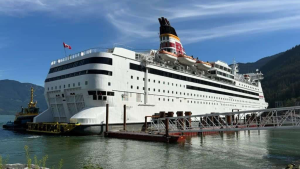Newfoundland-based Dynamic Air Shelters is providing a blast proof alternative for temporary or portable shelters.
A Newfoundland company is providing a blast proof alternative for temporary or portable shelters.
Dynamic Air Shelters originally produced inflatable 20 and 30-foot promotional domes with company logos for community events and different sports events, but the product line soon evolved.
It now includes utility and storage shelters for industry, rapid response shelters that could be used as field hospitals and logistics units in emergency situations, as well as shelters that can remain standing after an explosion.
The company has had two series of blast shelters at the Suffield Military Base in Alberta.
“What we’ve proven to this point (is) that (in) a 5.9 psi blast overpressure, the occupants and equipment inside the shelters would be safe,” said Kay Riggs, Dynamic’s vice president of operations.
“So we’ve gone from 4.5 to 5.9, and there’s some interest in proving that even farther, which means you have to keep improving and enhancing the shelter capabilities.”
Dynamic Air Shelters operates two manufacturing facilities in Grand Banks, Newfoundland and has 70 employees.
The products are distributed in Alberta by ATCO Structures and Logistics.
Dynamic Air Shelters was approached by some petrochemical companies, who were familiar with the domes and the rapid response shelters.
They asked how the shelters would perform in a blast overpressure situation.
It was a question the company didn’t have an answer for, but one they were prepared to put engineers to work on.
When initial engineering tests and simulations were conducted roughly five years ago, it was discovered the company’s product would perform in a blast overpressure situation of 4.5 psi.
A blast overpressure or shock wave of 4.5 psi is capable of collapsing most buildings, other than those made of concrete.
Riggs said once Dynamic had validation in theory that the structures could not only withstand the shockwave, but could protect the contents, including personnel, the petrochemical industry came on board and began buying the company’s product.
Subsequent blast testing, under controlled circumstances, has shown the product is capable of withstanding greater pressure than the initial testing revealed.
Dynamic is set to do further testing through consultants in late March or early April that would put their shelters in the path of a vapour cloud explosion.
It is a test that the company hopes will validate the shelter’s ability to keep contents and personnel safe during a flash fire explosion.
She said the key to the shelter’s ability to withstand blast pressure is a combination of the shelter’s support system and the fact it is filled with low pressure air.
The shelters’ frame is a series of vinyl columns that are bound together with what the company calls hug straps.
“It is a devise that keeps the columns in place and connected to the outer cover,” Riggs said of the patented technology.
“It’s the hug strap technology and placement that keeps the columns supportive and in place with the rest of the assembly.”
Those columns are filled with low pressure air that does not exceed 1.5 psi, allowing the structure to ride out the shock wave.
In the event of a puncture to the columns, the air loss is gradual.
If the columns were filled with high pressure air, the blast would be compounded.
“It doesn’t just collapse,” she said.
“If air went from all the columns, it would come down slowly. And, if you were under it, you would be under vinyl, not concrete or steel.
Dynamic’s shelters are made with layers of pvc (polyvinylchloride) with a polyester scrim in between.
Riggs explained the material is a fairly common fire retardant fabric that the company imports through North American distributors. All cutting and manufacturing is done at the two facilities in Grand Banks.
The company’s promotional domes and rapid response units are made from a lighter weight material – 10 ounce for the exterior and 18 ounce for the columns.
However, the blast-resistant shelters use a much heavier weight – 16 ounce for the exterior and 31 ounce for the columns.
Regardless of the type of shelter, the units can also be linked together with tunnels that can be inflatable like the shelters themselves or simply a cover connecting two units.
The company has also developed a system they call frag walls, which are two-foot deep walls that measure approximately eight feet in height and seven feet in width.
The walls are lined with Kevlar on the exterior, filled with sand, and used to surround a shelter in areas, where additional blast protection may be required, particularly military zones.
Riggs said the company has recently built an industrial shelter for an oil company in Northern Canada that measured 160-feet in diameter and 45-feet in height.
The shelter was used to cover a construction site so the workers could continue to work in subzero temperatures.
The shelters can be connected to HVAC systems, he said.

DYNAMIC AIR SHELTERS











Recent Comments
comments for this post are closed